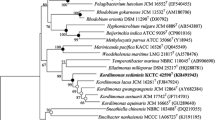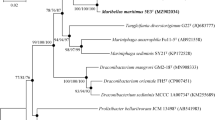Abstract
A yellow-pigmented, Gram-stain negative and facultatively anaerobic bacterium, designated MF326T, was isolated from a sample of sediment collected from a sea cucumber culture pond in Rongcheng, China (122°14′34″E 36°54′36″N). Cells of strain MF326T were found to be catalase negative and oxidase positive. Optimal growth was found to occur at 30 °C and pH 7.0–7.5 in the presence of 2.0–3.0 % (w/v) NaCl. Phylogenetic analysis based on 16S rRNA gene sequences revealed that strain MF326T is a member of the genus Mesonia and exhibits the high sequence similarity (94.3 %) with the type strain of Mesonia ostreae, followed by Mesonia algae (93.9 %). The dominant fatty acids of strain MF326T were identified as iso-C15:0, an unidentified fatty acid with an equivalent chain-length of 13.565 and anteiso-C15:0. The major polar lipids were found to be two unidentified lipids and phosphatidylethanolamine. The major respiratory quinone was found to be MK-6 and the genomic DNA G+C content was determined to be 40.7 mol%. On the basis of the phylogenetic analysis and differential phenotypic characteristics, it is concluded that strain MF326T (=KCTC 42255T =MCCC 1H00125T) should be assigned to the genus Mesonia as the type strain of a novel species, for which the name Mesonia sediminis sp. nov. is proposed.


Similar content being viewed by others
References
Bano N, Hollibaugh JT (2002) Phylogenetic composition of bacterioplankton assemblages from the Arctic Ocean. Appl Environ Microbiol 68:505–518
Bligh EG, Dyer WJ (1959) A rapid method of total lipid extraction and purification. Can. J. Biochem. Physiol. 37:911–917
Bowman JP (2000) Description of Cellulophaga algicola sp. nov., isolated from the surfaces of Antarctic algae, and reclassification of Cytophaga uliginosa (ZoBell and Upham 1944) Reichenbach 1989 as Cellulophaga uliginosa comb. nov. Int J Syst Evol Microbiol 50:1861–1868
Choi A, Baek K, Lee H, Cho JC (2015) Mesonia aquimarina sp. nov., a marine bacterium isolated from coastal seawater. Int J Syst Evol Microbiol 65:135–140
CLSI (2012) Performance standards for antimicrobial susceptibility testing; 22nd informational supplement m100-s22. Clinical and Laboratory Standards Institute, Wayne
Dong XZ, Cai MY (2001) Determination of biochemical characteristics. In: Dong XZ, Cai MY (eds) Manual for the systematic identification of general bacteria. Science Press, Chinese, Beijing, pp 370–398
Du ZJ, Wang Y, Dunlap C, Rooney AP, Chen GJ (2014) Draconibacterium orientale gen. nov., sp. nov., isolated from two distinct marine environments, and proposal of Draconibacteriaceae fam. nov. Int J Syst Evol Microbiol 64:1690–1696
Felsenstein J (1981) Evolutionary trees from DNA sequences: 226 a maximum likelihood 227 approach. J Mol Evol 17:368–376
Glöckner FO, Fuchs BM, Amann R (1999) Bacterioplankton compositions of lakes and oceans: a first comparison based on fluorescence in situ hybridization. Appl Environ Microbiol 65:3721–3726
Kang HS, Lee SD (2010) Mesonia phycicola sp. nov., isolated from seaweed, and emended description of the genus Mesonia. Int J Syst Evol Microbiol 60:591–594
Kim OS, Cho YJ, Lee K, Yoon SH, Kim M, NaH Park SC, Jeon YS, Lee JH, Yi H, Won S, Chun J (2012) Introducing EzTaxon-e: a prokaryotic 16S rRNA gene sequence database with phylotypes that represent uncultured species. Int J Syst Evol Microbiol 62:716–721
Kirchman DL (2002) The ecology of Cytophaga-Flavobacteria in aquatic environments. FEMS Microbiol Ecol 39:91–100
Kolberg J, Busse HJ, Wilke T, Schubert P, Kämpfer P, Glaeser SP (2015) Mesonia hippocampi sp. nov. isolated from the brood pouch of a diseased Barbour’s seahorse (Hippocampus barbouri). Int J Syst Evol Microbiol 65:2241–2247
Lee SY, Lee MH, Yoon JH (2012) Mesonia ostreae sp. nov., isolated from seawater of an oyster farm, and emended description of the genus Mesonia. Int J Syst Evol Microbiol 62:1804–1808
Leifson E (1963) Determination of carbohydrate metabolism of marine bacteria. J Bacteriol 85:1183–1184
Liu QQ, Li XL, Rooney AP, Du ZJ, Chen GJ (2014) Tangfeifania diversioriginum gen. nov., sp. nov., a representative of the family Draconibacteriaceae. Int J Syst Evol Microbiol 64:3473–3477
Mesbah M, Premachandran U, Whitman WB (1989) Precise measurement of the G+C content of deoxyribonucleic acid by high-performance liquid chromatography. Int J Syst Bacteriol 39:159–167
Minnikin DE, O’Donnell AG, Goodfellow M, Alderson G, Athalye M, Schaal A, Parlett JH (1984) An integrated procedure for the extraction of bacterial isoprenoid quinones and polar lipids. J Microbiol Methods 2:233–241
Nedashkovskaya OL, Kim SB (2011). Genus XXXIV. Mesonia Nedashkovskaya, Kim, Han, Lysenko, Rohde, Zhukova, Falsen, Frolova, Mikhailov, and Bae 2003a, 1970 emend. Nedashkovskaya, Kim, Zhukova, Kwak, Mikhailov and Bae 2006e, 2435. In: Krieg NR, Staley JT, Brown DR, Hedlund BP, Paster BJ, Ward NL, Ludwig W, Whitman WB (eds) Bergey’s manual of systematic bacteriology. The Bacteroidetes, Spirochaetes, Tenericutes (Mollicutes), Acidobacteria, Fibrobacteres, Fusobacteria, Dictyoglomi, Gemmatimonadetes, Lentisphaerae, Verrucomicrobia, Chlamydiae, and Planctomycetes, 2nd edn., vol 4. Springer, New York, pp 239–240
Nedashkovskaya OI, Kim SB, Han SK, Lysenko AM, Rohde M, Zhukova NV, Falsen E, Frolova GM, Mikhailov VV, Bae KS (2003) Mesonia algae gen. nov., sp. nov., a novel marine bacterium of the family Flavobacteriaceae isolated from the green alga Acrosiphonia sonderi (Kütz) Kornm. Int J Syst Evol Microbiol 53:1967–1971
Nedashkovskaya OI, Kim SB, Zhukova NV, Kwak J, Mikhailov VV, Bae KS (2006) Mesonia mobilis sp. nov., isolated from seawater, and emended description of the genus Mesonia. Int J Syst Evol Microbiol 56:2433–2436
Sasser M (1990) Identification of bacteria by gas chromatography of cellular fatty acids. MIDI technical note 101. MIDI Inc, Newark
Smibert RM, Krieg NR (1994) Phenotypic characterization. In: Gerhardt P, Murray RGE, Wood WA, Krieg NR (eds) Methods for general, molecular bacteriology. American Society for Microbiology, Washington, DC, pp 607–654
Tamaoka J, Komagata K (1984) Determination of DNA base composition by reversed-phase high-performance liquid chromatography. FEMS Microbiol Lett 25:125–128
Tamura K, Stecher G, Peterson D, Filipski A, Kumar S (2013) MEGA6: molecular evolutionary genetics analysis version 6.0. Mol Biol Evol 30:2725–2729
Thompson JD, Gibson TJ, Plewniak F, Jeanmougin F, Higgins DG (1997) The CLUSTAL_X windows interface: flexible strategies for multiple sequence alignment aided by quality analysis tools. Nucleic Acids Res 25:4876–4882
Tindall BJ, Sikorski J, Smibert RM, Kreig NR (2007) Phenotypic characterization and the principles of comparative systematics. In: Reddy CA, Beveridge TJ, Breznak JA, Marzluf G, Schmidt TM, Snyder LR (eds) Methods for general and molecular microbiology, 3rd edn. ASM Press, Washington DC, pp 330–393
Acknowledgments
This work was supported by the National Natural Science Foundation of China (31370057, 31370108), National Science and Technology Major Project of China (2013ZX10004217) and 2013 Shandong Provincial Second Group Projects on Resource Platforms for Marine Economic and Innovative Development Regions: Marine Microorganisms Preservation Platform (2150299).
Author information
Authors and Affiliations
Corresponding author
Additional information
The GenBank accession number for the 16S rRNA gene sequence of Mesonia sediminis MF326T is KR061432.
Electronic supplementary material
Below is the link to the electronic supplementary material.
Rights and permissions
About this article
Cite this article
Wang, FQ., Xie, ZH., Zhao, JX. et al. Mesonia sediminis sp. nov., isolated from a sea cucumber culture pond. Antonie van Leeuwenhoek 108, 1205–1212 (2015). https://doi.org/10.1007/s10482-015-0575-3
Received:
Accepted:
Published:
Issue Date:
DOI: https://doi.org/10.1007/s10482-015-0575-3




